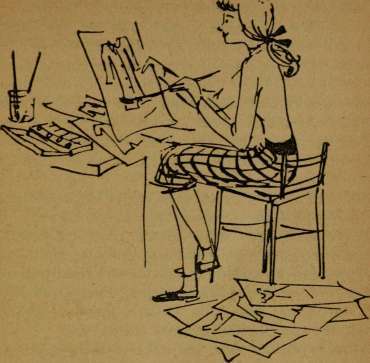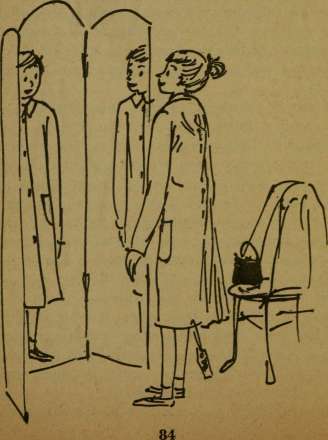5. Medium brown—fair to dark skin.
6. Redhead—fair to dark skin.

Note that your skin color is just as important as your hair color in determining what to wear. Too often, teens tend to overlook their skin color and think of themselves only by their hair color.
Brunettes with fair skin should play up the exquisite contrast of light and dark. They can look feminine in pastels, pale pink and blue, in dark shades like navy and deep green; and they can look ravishing in bright green and red.
Brunettes with dark skins can play exotic in tangerine tones, in reds, and in bright greens. They should be careful of yellows that tend to give their skin a sallow cast, but they can look to blues and beiges with success.
Blondes with fair skins need to accent their blondeness. If they wear dark colors they should lighten them with a pastel contrast. Navy is wonderful, particularly if freshened with a touch of white, pale pink or pale blue. All the pastels are wonderful to underscore the feminine and willowy look of a blonde. Mauve is a heady choice. As for gray—a good neutral'
Blondes with dark skins need to be careful of yellowing their skins. Keep clear of saffron colors and too-dead neutrals. Freshen up grays and beiges with touches of color at the neckline. Greens and the range of blues are excellent for those with hazel eyes.
Girls with medium brown hair—by far the most numerous, and the predominant American type, should be wary of overdoing the drab lines. Spike neutral grays and beiges with color—a lively, perky color like red, green, or blue. Don't be afraid of color—your medium coloring will react well to color in dress. Yellow in the bright ranges, green in all its variations, and blues, from pale to dark, are very good. True dashing red can be used to good effect.
Redheads should make the most of their coloring. Real redheads are few and far between, and those blessed with such distinctive coloring should make the most of it. Most redheads miss a good bet by timidity. Pink, a color they usually avoid, can be sensational. Red, however, can usually not be worn, as it will clash with the hair color. Blues and greens, in all their variations, are naturals for redheads, and white may be most effective, but only if the skin color is clear and alive. A redhead with a dead-white complexion should wear white with caution.
As with any rules, these are made to be broken, but break them only after due consideration. Make sure that every color you choose does something for you, and don't forget that your hair may not change color, but your skin can. It tans in the summer, fades in the winter. Keep that in mind when you buy your new clothes.
Finally, and I would say above all, above consideration of your figure and your color type, remember your personality. Often your personality and your figure type go hand in hand, but if they don't, stick to your personality as the best guide.
If you are the tailored type, if you like to be uncluttered and trim, then choose tailored clothes, simple skirts, classic jackets, box coats. Keep to the simple even in your date dresses—dirndl skirts and shirtwaist blouses or bateau-necked sweaters and jerseys. Use rich fabrics for distinction, make them dominate the silhouette.
If you are all feminine, then choose clothes that play up that quality. Full skirts, jackets fitted and peplum-flared, puffed sleeves, ruffled shoulders and hemlines, delicate touches of ribbon and lace. But in the midst of all these fripperies maintain a sense of balance. Don't overdo. Don't mix peplum and ruffles, lace and bows. Keep feminine but don't dress like a candy box.
If you are in between, go your own sweet way, being feminine one day, tailored the next. But do take some stand —don't overdo the inbetweenness. Get to be known for your sense of color or your sense of accessory. Be the girl who knows her way with a scarf or can do a million and one tricks with a strand of pearls. Develop an outstanding characteristic of dress that people associate with you and you alone.
All of you, feminine, tailored, or in between, have one big desire in common. Teens seem to have a universal aching for that first black dress. Usually this involves a long-drawn-out battle with the family and ends in general weariness and a sense of defeat on both sides. If your family do not want you to choose black because they feel you are too young, don't argue. Navy blue is just as good. Black is a color you'll see a good deal of when you are older, so don't rush headlong into it. It's not worth the fight.
None of this advice is startling or particularly new, but it is sound. Happy mediums have been held up as the happy way of life since philosophy began, and the reason that each new generation comes to rediscover the principle is that, by golly, it works.
Next to knowing your type, and dressing to suit it, you must also be sure of your size. Ill-fitting clothes never look well, and buying clothes that don't fit with the intention of having an extensive alteration job done is an expensive luxury. You will find your clothes fit better if you shop for things you know are in your size range. Most teen-agers fall into three classifications: teen sizes for the younger teens (sizes 10—14A), especially those girls with undeveloped busts; juniors (9-15 or 17) for the proportionately short-waisted figure; and misses (10—18) for the normally long-waisted, above five-feet-five figure.

When you are shopping, look out for fit. Make sure that the shoulders fit smoothly, that the waistline of the dress and your own waistline match each other. Look for details such as gaping collars (too large for the neck) and too snug hips. Check the back view; see that the fabric is not all bunched under the arms and above the waistline in back. These all take major alterations, necessitating reshaping the dress. Alterations like sleeve length and hemlines, as well as waistline adjustments, can easily be taken care of, and every teen should learn to do these things herself.
Perhaps you have heard your mother say (and groaned to hear it) that it is better to buy a larger size than a smaller one. You remember too well the awful days when you were very young and your clothes were bought outsized in the hope that you could grow into them. I'm not advocating a return to such trials, but I do agree with your mother that a too-small dress or suit or coat can never be altered successfully, whereas a large size has a better chance. Clothes can be taken in more easily than they can be let out. You are wiser to buy clothes to fit the biggest part of you (probably your hips) than to fit your smallest part (your waist). Never buy clothes that fit like sausage skins with the intention of losing weight to fit them, or in the hope that you will seem smaller if you wear a smaller size. Instead buy a size that most nearly fits your figure, and then, if there are any adjustments, make them.
If you have really serious difficulty in getting clothes to fit properly (and even if you don't), I think one of the smartest things any teen can do is to learn to make her own clothes. Not only is sewing saving, but your clothes will fit you in every dimension because they are cut to your own individual measurements.
Sewing is not difficult. Most schools offer it in their programs, and it is a wise teen who elects it. You need not, of course, study sewing at school. You can have your mother teach you or, failing that, get instruction from a qualified sewing center. The time you take in learning how to thread a needle and how to master a sewing machine will be repaid many times over in good-looking clothes, well-fitting clothes, and more clothes, because you can usually afford more if you sew at home than if you buy them ready-made.